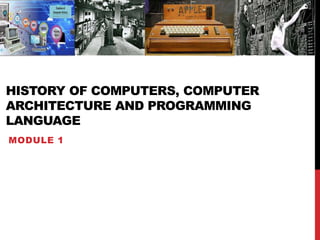
CPE- 121WEEK1
- 1. HISTORY OF COMPUTERS, COMPUTER ARCHITECTURE AND PROGRAMMING LANGUAGE MODULE 1
- 4. GENERATION OF COMPUTER ACCORDING TO COMPONENTS
- 5. FIRST GENERATION: 1937 – 1946 1937 the first electronic digital computer was built by Dr. John V. Atanasoff and Clifford Berry. It was called the Atanasoff-Berry Computer (ABC). 1943 an electronic computer name the Colossus was built for the military. 1946 the first General–Purpose digital computer Electronic Numerical Integrator and Computer (ENIAC) was built. weighed 30 tons, and had 18,000 vacuum tubes which was used for processing. Computers of this generation could only perform single task, and they had no operating system
- 7. ENIAC Electronic Numerical Integrator and Computer, built by J. Presper Eckert and John V. Mauchly was a general-purpose computer. It had been very heavy, large, and contained 18,000 vacuum tubes.
- 8. SECOND GENERATION: 1947 – 1962 This generation of computers used transistors instead of vacuum tubes which were more reliable 1951 the first computer for commercial use was introduced to the public; the Universal Automatic Computer (UNIVAC 1). 1953 the International Business Machine (IBM) 650 and 700 series computers made their mark in the computer world. During this generation of computers over 100 computer programming languages were developed, computers had memory and operating systems. Storage media such as tape and disk were in use also were printers for output Programming language was shifted from high level to programming language and made programming comparatively a simple task for programmers. Languages used for programming during this era were FORTRAN (1956), ALGOL (1958), and COBOL (1959).
- 10. THIRD GENERATION: 1963 - 1971 The invention of integrated circuit brought us the third generation of computers. With this invention computers became smaller, more powerful more reliable and they are able to run many different programs at the same time. As compared to second-generation computers, 3rd generation computers were cheaper in price, smaller in size, less heavy in weight, faster in speed and more efficient. High-level programming languages such as ALGOL-68, FORTRAN-II TO IV, BASIC, COBOL, PASCAL PL/1 were used. These computers were introduced with magnetic storage.
- 11. FOURTH GENERATION COMPUTERS (1971-PRESENT) In 1971 First microprocessors were used, the large scale of integration LSI circuits built on one chip called microprocessors. The most advantage of this technology is that one microprocessor can contain all the circuits required to perform arithmetic, logic, and control functions on one chip. Technologies like multiprocessing, multiprogramming, time-sharing, operating speed, and virtual memory made it a more user-friendly and customary device. The concept of private computers and computer networks came into being within the fourth generation In the fourth generation, multiple high-level languages like BASIC, PASCAL, COBOL, FORTRAN, and C language were developed. The use of data communication was widespread because of these computers. The development of the networking between the systems began in the fourth-generation computers.
- 13. ALTAIR SERIES
- 14. APPLE II
- 15. APPLE II SERIES
- 16. IBM PC
- 17. FIFTH GENERATION COMPUTERS The technology behind the fifth generation of computers is AI. It allows computers to behave like humans. It is often seen in programs like voice recognition, area of medicines, and entertainment. Within the field of games playing also it’s shown remarkable performance where computers are capable of beating human competitors. Based on artificial intelligence, uses the Ultra Large-Scale Integration (ULSI) technology and parallel processing method (ULSI has millions of transistors on a single microchip and Parallel processing method use two or more microprocessors to run tasks simultaneously).
- 19. COMPUTER ARCHITECTURE A typical computer today has five basic components: RAM CPU storage devices, I/O (input/output) devices, Communication devices
- 20. COMPUTER SYSTEMS A computer system is a combination of all the components required to process and store data using a computer. Every computer system is composed of multiple pieces of hardware and software. Hardware is the equipment, or the physical devices, associated with a computer. Software is computer instructions that tell the hardware what to do. Software is a programs, which are instruction sets written by programmers.
- 21. SOFTWARE CAN BE CLASSIFIED INTO TWO BROAD TYPES: Application Software comprises all the programs you apply to a task, such as processing programs, spreadsheets, payroll and inventory programs, and games. System Software comprises the programs that you use to manage your computer, including operating systems such as Windows, Linux, or UNIX for larger computers and Google Android and Apple iOS for smartphones..
- 23. PROGRAMMING LANGUAGES Programming languages are broadly classified into three levels: machine languages, assembly languages high-level languages. Machine Language is the only programming language the CPU understands. Each type of CPU has its own machine language. Assembly Language is a type of low-level programming language that is intended to communicate directly with a computer’s hardware.
- 26. JAVA Object-Oriented Programming Developed by James Gosling and his team at Sun Microsystems in California.
- 27. C LANGUAGE JAVA
Editor's Notes
- Low-level programming languages such as assembly language are a necessary bridge between the underlying hardware of a computer and the higher-level programming languages—such as Python or JavaScript—in which modern software programs are written.